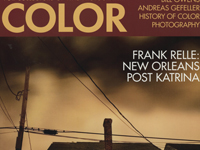
By Dean Brierly
Ina sense, all photography is fiction. Even the most objective documentary image is subject to the perspective of the photographer, the context in which it was made, and the prejudices of those who view it. At best, photographs are half-truths. Few photographers, however, seem conscious of this aspect of the medium.
Fewer still address it in their work. Among the notable exceptions is Germany's Andreas Gefeller, who has made visual misdirection and deception the very basis of his aesthetic. His first major series, Halbwertzeiten (half-lives), explored the line between visibility and invisibility in photos taken near Chernobyl, where thousands of people had to leave their homes due to the 1986 nuclear disaster. "Radioactivity is still everywhere, but you cannot see or photograph it. But just by knowing where these photos were taken, you can sense radioactivity in the pictures," Gefeller says. His next project, Soma, demonstrated that while the human eye generally sees things at night in various shades of grey, the camera records colors as they are. "In this case, it is our eyes that show a false picture ofthe world, not the camera."
Gefeller's Supervisions series further destabilizes the notion of photographic reality by offering views of urban areas taken from a seemingly vertiginous bird's-eye perspective. Yet not only are the images made from only a few feet above the ground, they are also composite constructions that are digitally stitched together from up to 2,500 separate exposures. Gefeller merely points his camera straight down at the ground and "maps out" the terrain one meter at a time. The images aren't modified or enhanced in any way, merely joined together in the computer.
By creating a false perspective that appears authentic, Gefeller jolts the viewer's sense of spatial depth and raises
doubts about his pictures' veracity. The series is further contextualized through its evocation of spy satellite imagery, lending ironic comment on our complacent expectations of personal privacy. As if that weren't enough disorientation, the Supervision images also play with notions of time: While viewers probably assume each photograph was taken in the standard I 25th of a second, the image capture process alone takes hours, and the
digital compositing can take days.
"Is my work just an illusion? No, of course not. Everything you see in my pictures was there, nothing was deleted and nothing was added," Gefeller says. " Is my work just documentation? No, the perspective is completely unreal! The Supervisions series lies somewhere between documentary and fictional photography."
There's method to this madness, as the manner in which the images are made is directly related to the messages Gefeller wants to convey. "If you look at these works carefully, you'll note that many were taken at places where man has arranged everything in rows: fences, stadium seats, crosswalk lines. This reveals an obsession with asserting control over the natural environment, as if nature is our enemy. As a result, the border
between nature and urban spaces is vanishing. Even worse is our attempt to simulate nature in the context of modem architecture, garden and park design, and so forth. It makes me wonder how future generations will deal with nature."
Yet the "Supervisions" series also suggests that such efforts at environmental manipulation will ultimately lack permanency. Witness the vegetation pushing up between the cracks in Gefeller's image of paving slabs, for example. Even the spatial disruption in otherwise neat rows of stadium seats seems to imply that nature will eventually reassert its primacy, even if mankind is no longer around to witness it. This reading is supported
by the marked absence of people in any of the images.
"I'm quite strict about excluding people from these public places," Gefeller notes. "My images don't give you a sense that people have temporarily left these places and will soon return. Instead, and more disturbing, they make you think they were taken at a point far in the future-after man has left the Earth."
As a child, the Dusseldorf native (born in 1970) took an interest in astronomy and the way that satellite images of planets seemed to be taken from a greater distance in space than they actually were. That childhood fascination came flooding back to him one day while picnicking with a friend on the banks of the Rhine River. "It was a nice day, and we were a little bored. When my friend felt asleep, I started playing with my film camera and made dozens of photos of the ground while walking over it. When I combined cut-out images from the contact sheets into a collage, I realized that with this method I could 'fly’- not literally, of course, but in a photographic way. That was the start of Supervisions."